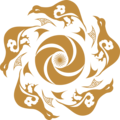Color also played a marked role in wedding rituals, where white was used as a symbol of purity and kindness while the red color was believed to guard people from evil spirits. To mourn someone’s death, people used blue, black and white colors. Multicolored fabrics (haftrangi – seven colors) were believed by ancient people to keep various diseases and bad luck at bay. As was noted above, people at the time wore several garments simultaneously harmoniously; their varied colors and patterns created unparalleled color combinations that were a feast for the eyes.
You will find more examples of national Uzbek clothes in the book-album "Traditional Uzbek costume on materials of museum and private collections of Uzbekistan (Part 1)" (volume XLVIII) from the series "Cultural legacy of Uzbekistan in the world collections."
The general sponsor of the project is the oilfield services company Eriell-Group.
What is the role of color in traditional Uzbek costume?
A big role in Uzbek costumes was the color that marked the wearer’s status, age and descent. It was linked with religious and magic rituals.
